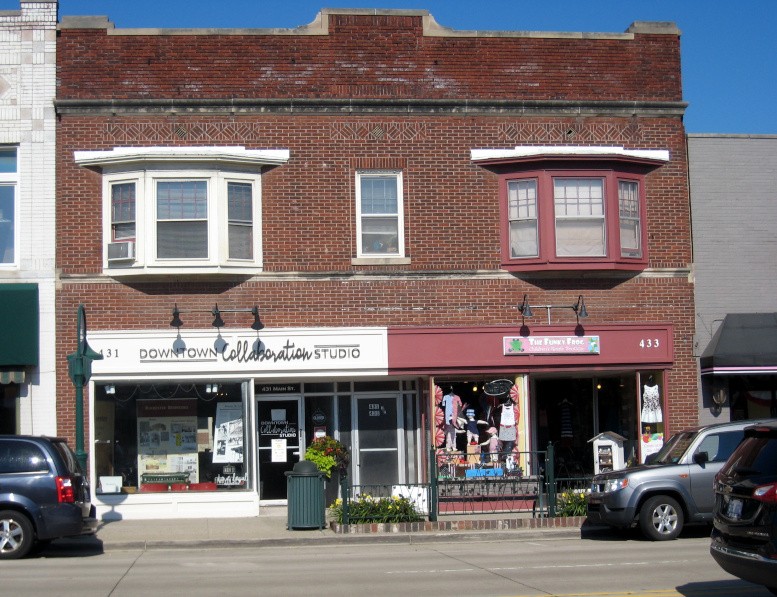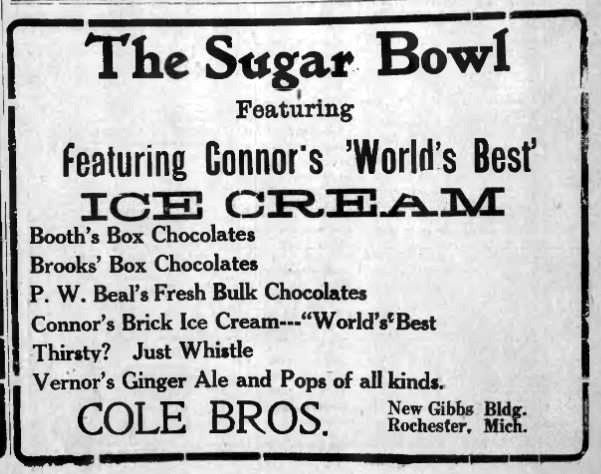Oliver P. Gibbs Block
Introduction
Text-to-speech Audio
Images
Oliver P. Gibbs Block, east elevation, 2020

Newspaper advertisement for the Cole Brothers Sugar Bowl in the Gibbs Block, 1921

Backstory and Context
Text-to-speech Audio
Oliver P. Gibbs, who broke ground for the business block located at 431-433 S. Main in September 1919 and opened it to tenants in early 1920, was well-known in Rochester not for his business activities, but for his political ones. Gibbs served as Supervisor of Avon Township from 1927 to 1952, and also served two terms as chairman of the Oakland County Board of Supervisors. He led the township during a time of spectacular growth and development, when the first planning and zoning efforts were made for what would eventually become the city of Rochester Hills.
Gibbs was born in Indiana on July 9, 1873. He married Cora D. Glaspie, a native of Oxford, Michigan, on April 16, 1910 in Covington Kentucky. Cora D. Gibbs died on April 23, 1944, and Oliver P. Gibbs died on December 9, 1955.
One of the first tenants in Gibbs' new building was Mac's Furnishings, a menswear store at 431 S. Main. At 433 S. Main, the Cole Brothers Sugar Bowl, an ice cream and confectionery shop, held its grand opening on April 16, 1921. The Rochester Era described the Sugar Bowl as "elegant," and having an all-white interior with booths lining both walls. No doubt the business benefited nicely from the patronage of moviegoers at the Idle Hour Theatre directly next door. The Sugar Bowl operated until 1929.
In 1927, Consumers Power Company took a long-term lease on 431 S. Main and opened a local office that would serve the community for the next half century. In February 1930, A.F. Zimmerman and his son, Earl, moved their shoe store up the block to the 433 address, replacing the Sugar Bowl in the north half of the building. For more than fifty years to follow, a shoe store would occupy the space, as Jack Burr's bootery followed Zimmerman's in the same location in 1957.
Consumers Power closed its Rochester office in late 1972, and Burr's Bootery closed in 1992, after expanding into the former gas company space. In recent years, a variety of businesses have come and gone, including Ballen Supply and Flair Boutique at 431, and Record Time, Brooklyn Pizza and the Silk Worm at 433. In 2020, the tenants were the Downtown Collaboration Studio at 431, and the Funky Frog at 433.
Sources
"O.P. Gibbs will remove the old Hiram Lambertson house next to the Idle House, within thirty days and at once commence operations on a new brick block of two stories, 20x100," Rochester Era, September 19, 1919.
"New Ice Cream & Confectionery Parlor: Cole Brothers," [display advertisement], Rochester Era, April 15, 1921.
"The opening of 'The Sugar Bowl,' Cole Brothers' new ice cream and confectionery parlors last Saturday...," Rochester Era, April 29, 1921.
"Consumers Power Co. Lease Gibbs Building," Rochester Clarion, August 5, 1927, p.1.
"Open New Office and Sales Room," Rochester Era, August 12, 1927, p.4.
"Zimmerman Shoe Store Marks its 25th Anniversary," Rochester Era, June 28,1945, p.1
"Veteran Politician Passes: Oliver P. Gibbs Dies After Brief Illness," Rochester Clarion, December 15, 1955, p.1.
"Former Korean Veteran Operates Shoe Store Here," Rochester Clarion, March 14, 1957, p.1.
"Popular Rochester Shoe Store Closes After 35 Years," Rochester Clarion, June 11, 1992.
Deborah Larsen
Rochester Era, May 27, 1921, p.1.
